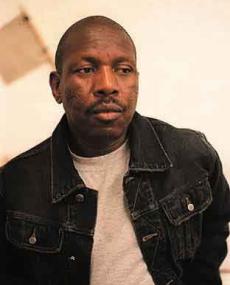
Jabulani Sam Nhlengethwa was born on 9 January 1955 in the Payneville township of Springs, Gauteng (formerly Transvaal). Forced removals in the area made his family relocate to Kwa-Themba. He spent much of his childhood there as well as in Ratanda, Heidelberg with his grandmother. He attended the Evangelical Lutheran Church (ELC), Art and Craft Centre at Rorke’s Drift and studied at the Johannesburg Art Foundation.
Nhlengethwa became interested in art at an early age. He began assembling his art collection in 1977 during his first year at Rorke’s Drift, swapping his own work for pieces by his schoolmates. In his own art, he drew inspiration from the townships where he grew up. Time spent talking with older members of the community in shebeens and with his older brother, Rayda Becker Jabulane, a jazz musician, helped shape Nhlengethwa’s work. In addition to building his art collection, he collected jazz records from the age of 17. He commented that ‘when I do things about jazz it’s a tribute to my brother’.
After graduating from Rorke’s Drift, Nhlengethwa taught part-time at the Johannesburg-based Federative Union of Black Artists (FUBA) and travelled extensively. He studied at the Mofolo Art Centre in Soweto, and participated in Thupelo and Triangle workshops. He cofounded the Bag Factory Artists’ Studio in Johannesburg in 1991, mainly to provide studio space to black artists who had little access to artistic resources. He won the Standard Bank Young Artist award in 1994. For 13 years he worked as a television technician for SABC, at the time a predominately white institution.
Nhlengethwa was neither the first nor only artist in South Africa to use collage but it is the way that he uses the hard-edge cut shapes of ready-made images that is different and individual. Carefully selected reproductions from magazines are cut out and cut up and then juxtaposed to make new images, usually people or faces. Often these newly-constructed forms are combined with other media. What matters to Nhlengethwa is the content of the image and bits of paper were not often used as fillers or backgrounds. During the last few years Nhlengethwa has started working with the Artists’ Press using the photogravure process, because, among other features, he claims ‘it has an element of collage in it … it entails digitalising an initial collage’. By the time he started working with photogravure and lithographs Nhlengethwa had a well-established iconography but the new medium created a space for the urban artist to make multiples and develop series on selected themes. Among these are labour (Mine workers), political history (Glimpses of the Fifties and Sixties), interiors, music and the personal. He has also worked in the mediums of photogravure and lithographs.
He has exhibited throughout South Africa as well as globally including and not limited to: Germany, France, the United States, Botswana, Brazil, Egypt, Japan and Cuba. Collections at the Johannesburg Art Gallery, the Iziko South African National Gallery, the Durban Art Gallery and numerous other public and private institutions include his work. He is represented by the Goodman Gallery in South Africa.